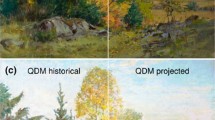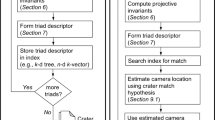Abstract
Imaging problems are becoming increasingly important due to the development of systems for aerospace monitoring of the Earth, radio and sonar location, medical devices for early diagnosis of diseases, etc. However, most of the work on image processing is related to images defined on rectangular two-dimensional grids or grids of higher dimensions. In some practical situations, images are defined on a cylinder (for example, images of pipelines, blood vessels, rotation details) or on a circle (for example, images of a facies (thin film) of dried biological fluid, an eye, a cut of a tree trunk). The specifics of the field of assignment of such images must be taken into account in their models and processing algorithms. In this paper, autoregressive models of cylindrical and circular images are considered and expressions of the correlation function are given depending on the autoregressive parameters. Spiral scanning of a cylindrical image can be viewed as a quasi-periodic process due to the correlation of image lines. To represent heterogeneous images with random heterogeneity, “double stochastic” models are used, in which one or several control images set the parameters of the resulting image. The available image can be used to estimate the parameters of the model of its control images. However, this is not sufficient to fully identify the hidden control images. It is also necessary to evaluate their covariance functions and find out whether they correspond to the hypothetical ones. The paper proposes a test for testing the hypotheses about the covariance functions of cylindrical and circular images with a study of its power relative to the parameters of the image model.














Similar content being viewed by others
REFERENCES
T. W. Anderson, The Statistical Analysis of Time Series (John Wiley & Sons, Inc., New York, 1971).
V. E. Dement’iev, V. R. Krasheninnikov, and K. K. Vasil’ev, “Representation and processing of spatially heterogeneous images and image sequences,” in Computer Vision in Control Systems-5, Ed. by M. N. Favorskaya and L. C. Jain (Springer, Cham, 2015), pp. 53–98.
I. C. Gruzman, V. P. Kirichuk, G. I. Kosikh, G. I. Peretryagin, and A. A. Spector, Digital Image Processing in Informative Systems (Novosibirsk State Tech. Univ., 2000) [in Russian].
R. C. Gonzalez and R. E. Woods, Digital Image Processing, 4th ed. (Pearson Education, 2017).
I. B. Gurevich and V. V. Yashina, “Algebraic interpretation of image analysis operations,” Pattern Recognit. Image Anal. 29 (3), 389–403 (2019).
A. Habibi, “Two-dimensional Bayesian estimate of images,” Proc IEEE 60 (7), 878–883 (1972).
L. C. Jain and M. N. Favorskaya, “Innovative algorithms in computer vision,” in Computer Vision in Control Systems-4, Ed. by M. N. Favorskaya and L. C. Jain (Springer, Cham, 2018), pp. 1–10.
V. R. Krasheninnikov, “Correlation analysis and synthesis of random field wave models,” Pattern Recognit. Image Anal. 25 (1), 41–46 (2015).
V. R. Krasheninnikov and E. A. Gladkikh, “The criterion for testing hypotheses about the covariance function and spectral density of a random process,” Autom. Manage. Processes 1 (35), 24–30 (2014).
V. R. Krasheninnikov, Yu. E. Kuvayskova, and A. U. Subbotin, “Pseudogradient algorithm for identification of doubly stochastic cylindrical image model,” Procedia Comput. Sci. 176, 1858–1867 (2020).
V. R. Krasheninnikov, O. E. Malenova, and A. U. Subbotin, “The identification of doubly stochastic circular image model,” Procedia Comput. Sci. 176, 1839–1847 (2020).
V. R. Krasheninnikov and K. K. Vasil’ev, “Multidimensional image models and processing,” in Computer Vision in Control Systems-3, Ed. by M. N. Favorskaya and L. C. Jain (Springer, Cham, 2018), pp. 11–64.
B. T. Polyak and J. Z. Tsypkin, “Optimal pseudogradient adaptation procedure,” Autom. Remote Control 8, 74–84 (1980).
V. A. Soifer, S. B. Popov, V. V. Mysnikov, and V. V. Sergeev, Computer Image Processing, Part I: Basic Concepts and Theory (VDM Verlag Dr. Muller, 2009).
Yu. V. Vizilter, Yu. P. Pyt’ev, A. I. Chulichkov, and L. M. Mestetskiy, “Morphological image analysis for computer vision applications,” in Computer Vision in Control Systems-1, Ed. by M. N. Favorskaya and L. C. Jain (Springer, Cham, 2015), pp. 9–58.
K. K. Vasil’ev, V. E. Dement’ev, and N. A. Andriyanov, “Doubly stochastic models of images,” Pattern Recognit. Image Anal. 25 (1), 105–110 (2015).
J. W. Woods, “Two-dimensional Kalman filtering,” Top. Appl. Phys. 42, 11–64 (1981).
Yu. I. Zhuravlev, “An algebraic approach to recognition and classification problems,” Pattern Recognit. Image Anal. 8, 59–100 (1998).
Funding
This study was supported by the Russian Foundation for Basic Research, project no. 20-01-00613.
Author information
Authors and Affiliations
Corresponding authors
Ethics declarations
COMPLIANCE WITH ETHICAL STANDARDS
This article is a completely original work by the authors, it has not been previously published, and it will not be published in other publications.
CONFLICT OF INTEREST
The authors state that they have no conflict of interest.
Additional information

Viktor Rostislavovich Krasheninnikov. Born May 27, 1945. Diploma Mathematician (Computing Mathematics), 1967, Kazan State University, Kazan, USSR; Candidate’s degree in Technical Sciences (Mathematical Cybernetics), 1971, Kiev Institute of Cybernetics, Kiev, USSR. Doctoral degree in Technical Sciences, 1995, Leningrad Electrotechnical Institute, Leningrad, USSR; Professor, 1996, Ulaynovsk State Technical University, Ulaynovsk, Russian Federation. Head of the Department of Applied Mathematics and Informatics at Ulaynovsk State Technical University, Ulaynovsk, Russian Federation. Research interests: statistical methods of signals and images processing: wave and autoregressive models of images on rectangular and curvilinear grids, special types of statistics of the decision rule for object detection, pseudogradient algorithms for forecasting, filtering and mapping of signals and images, recognition of speech signals by transforming them into images, and analysis of images of bones and facies of human biological fluids for medical diagnostics. He is the author of 5 monographs and more than 350 scientific papers in peer reviewed journals and proceedings indexed in Web of Science, Scopus and Russian Science Citation, holder of 4 patents. Web of Science: 36 papers; 7 citations in 7 documents, Hirsh index is 2; SCOPUS: 37 papers, 86 citations in 49 documents, Hirsh index is 5; Russian Science Citation Index: 164 papers, 1181 citations, Hirsh index is 15. He was the head of several projects at the Russian Foundation for Basic Research. He is the Scientific Secretary of the Ulyanovsk Regional Branch of the National Committee for Pattern Recognition and Image Analysis of the Russian Academy of Science. Teaching practice: Ulyanovsk State Technical University, Ulyanovsk (professor), Russia and University of Nigeria in Nsukka, Nigeria (visiting senior lecturer). He was supervisor of 10 PhD students and many graduate and master students.

Yuliya Evgenevna Kuvayskova. Born July 1, 1984. Diploma in Engineering Mathematics, Ulyanovsk State Technical University, Russian Federation, 2006. Candidate’s degree in Technical Sciences, 2010, Ulyanovsk State Technical University, Ulyanovsk, Russia. Associate Professor of the Department of Applied Mathematics and Informatics, Ulyanovsk State Technical University, Ulyanovsk, Russia. Research interests: time series analysis, statistical forecasting methods, machine learning, fuzzy logic, and technical diagnostics. She is the author of 125 papers in peer-reviewed journals, conference proceedings, and seminars. Web of Science: 4 papers; Scopus: 12 papers, 23 papers, Hirsch index is 3; Russian Science Citation Index: 103 papers, 667 citations, Hirsch index is 15. She was the head of a project at the Russian Foundation for Basic Research. Teaching practice: Ulyanovsk State Technical University, Ulyanovsk, Russia (assistant professor). She was supervisor of several graduate and master students.

Ol’ga Evgen’evna Malenova. Born July 5, 1991. Diploma in Engineering Mathematics Ulyanovsk State Technical University, Russian Federation, 2013. Leading specialist at the Research and Education Center “Boiling Point” of Ulyanovsk State Technical University. Research interests: statistical algorithms for image processing; mathematical models of circular images; pseudogradient algorithms for image identification, prediction and filtering; testing hypotheses about the covariance function of the image; identification of the features of the covariance function of circular images; distinguishing between normal and pathological types of human biological fluid facies; detection and recognition of markers on images of facies for early medical diagnosis. Author of 19 papers in peer-reviewed journals, conference materials and seminars.
Web of Science: 3 papers; Scopus: 8 papers; Russian Science Citation Index: 18 papers. Postgraduate studies: the topic of her Ph.D. thesis is “Development of algorithms and programs for early diagnosis of medical images”. Participates as an executor of two projects at the Russian Foundation for Basic Research: “Development of algorithms and software for early diagnosis of medical images” and “Development of mathematical models and algorithms for processing circular and cylindrical images.” Teaching practice: Ulyanovsk State Technical University, Ulyanovsk, Russia (assistant).

Alexey Subbotin. Born May 29, 1986. Diploma in Engineering Mathematics Ulyanovsk State Technical University, Russian Federation, 2009. Postgraduate student of the Department of Applied Mathematics and Informatics, Ulyanovsk State Technical University, Ulyanovsk, Russia. Research interests: statistical algorithms for image processing; mathematical models of cylindrical and circular images; identification of the features of the covariance function of cylindrical and circular images; accuracy evaluating of pseudogradient algorithms for image identification, prediction and filtering; testing hypotheses about the covariance function and evaluating the power of the test. Author of 17 papers in peer-reviewed journals, conference materials, and seminars. Web of Science: 3 papers; Scopus: 5 papers; Russian Science Citation Index: 15 papers. Participates as an executor of the project at the Russian Foundation for Basic Research: “Development of mathematical models and algorithms for processing circular and cylindrical images.” Teaching practice: Ulyanovsk State Technical University, Ulyanovsk, Russia (assistant).
Rights and permissions
About this article
Cite this article
Krasheninnikov, V.R., Kuvaiskova, Y.E., Malenova, O.E. et al. Testing Hypotheses about Covariance Functions of Cylindrical and Circular Images. Pattern Recognit. Image Anal. 31, 431–442 (2021). https://doi.org/10.1134/S1054661821030159
Received:
Revised:
Accepted:
Published:
Issue Date:
DOI: https://doi.org/10.1134/S1054661821030159




